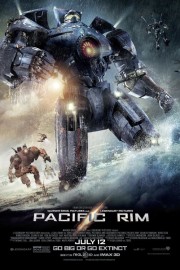Pacific Rim
I think my favorite shot in Guillermo Del Toro’s thrilling adventure epic, “Pacific Rim,” is one that happens late in the movie. The final showdown between man and monster takes place by “the breach” at the ocean floor, as two of the gigantic man-controlled robots, known as Jaegers (which is German for “hunter”) are facing off against three deadly Kaiju (the Japanese word for “giant beasts”). A nuclear blast is set off by one of the Jaeger, which rocks the ocean floor and destroys two of the Kaiju. The other Jaeger braces itself against the blast’s force, which turns the ocean floor into a barren dune before the water comes racing back with unbearable strength. That in itself is a remarkable image, but it’s make truly special as we see the fish flop on to the ground, as if they were on land, before the water comes back.
This image, which is- to be fair- also something of a spoiler, is also indicative of the sort of detail Del Toro brings to his films, whether it’s something small like “Cronos,” “The Devil’s Backbone,” and “Pan’s Labyrinth,” or something bigger such as his “Hellboy” films or “Pacific Rim.” The Mexican master of fantasy and horror is not one to play it safe, or cut corners, which makes even his lesser films (such as “Mimic”) much more satisfying than your average Hollywood fare. With “Pacific Rim,” he’s doing something quite unusual, and bringing that sensibility to a mega-budget movie, and though it seems, at first, out of his cinematic spectrum, the film fits right in by the time it’s done.
The film feels out of place within Del Toro’s filmography for another reason: as stories go, it’s fairly standard issue. That shouldn’t be held against it, however, because Del Toro and co-writer Travis Beacham, who came up with the initial idea, infuse that “standard” story with a sense of depth and feeling that makes it come alive. “Pan’s Labyrinth” this is not, but I kept coming back to the original “Star Wars” when I was looking at films to compare it to. On the surface, that movie is pretty standard, with relatively flavorless dialogue, as well; but as with “Pacific Rim,” what separated “Star Wars” from not just what came before, but also after, was a fusion of big ideas and remarkable special effects that showed us things we’d never seen before.
In terms of special effects, this is some of Industrial Light & Magic’s finest work. Ever. Including the original “Star Wars” trilogy. Although I will definitely be buying this film on Blu-Ray, it’s hard to imagine it will have some of the same impact on the small screen. This is a film that demands to be seen on the largest screen you can drive to, and I assure you, you will be glad you took the time for the trip. This is epic battle sequences between two gigantic foes on a scale that, I should hope, will make Michael Bay green with envy, and realize that the challenge has been laid for “Transformers 4.” Good luck. From the first sight of a Kaiju, which doesn’t even fit within the frame, destroying the Golden Gate Bridge during the prologue to that underwater battle alluded to earlier, Del Toro is bringing us destruction on a scale that the makers of those “Godzilla” movies that serve as obvious inspiration couldn’t possibly imagine. If for the action he stages alone, Del Toro’s has made my favorite blockbuster of the summer.
However, I’d be remiss if I didn’t credit the story, which focuses on the last days of the Kaiju war, for helping seal the deal. The crux of the narrative involves a former Jaeger pilot named Raleigh (Charlie Hunnam) having to put the past behind him (he lost his brother and co-pilot, Yancy, in a Kaiju battle five years before) to make one, last stand for humanity. His new co-pilot is Mako (the superb Rinko Kikuchi, who was an Oscar nominee for “Babel”), who carries her own baggage into battle. That’s a tough prospect since piloting a Jaeger requires the two pilots to connect their minds, and memories, in a process known as Drifting. If the two are in sync with one another, the better they are in combat. But the Kaiju are adapting in the final days, and they are proving difficult to defeat for even the best Jaeger pilots left. I’m sure you will still see where this film is heading by the end, however.
Drifting is the “big idea” at the heart of “Pacific Rim,” and while the sight of giant robots fighting giant monsters is the hook, drifting is what drives the narrative, and not just when it comes to Raleigh and Mako piloting together. Charlie Day is along for the ride as a scientist obsessed with the Kaiju who figures out that the best way to beat them is to drift with a still-functioning portion of a Kaiju brain, which is easier said than done. Thankfully, Hannibal Chau (Del Toro’s Hellboy, Ron Pearlman) is around to get some black market Kaiju organs for Day. How many blockbusters would give us a glimpse at such a seedy practice? Not many, but that’s why Guillermo Del Toro was the ideal choice for “Pacific Rim”- he’s fearless in what he shows the audience, to say nothing of a man of great artistic vision who is perfectly suited to such a creature feature, because he can get under your skin. And even though it’s fun first, “Pacific Rim” does just that.










